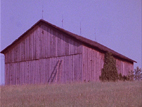Barn Rushes
- Larry Gottheim |
- 1971 |
- 36 minutes |
- COLOR |
- SILENT
Rental Format(s): 16mm film, 18 fps / Digital File
Sale Format(s): DVD
" I noticed a play of moving light between the slats of an old barn I passed every day on the way to my house. This led me to film it from a car window as the car drove up the road, turned and continued up the hill. I filmed it in extreme slow motion - the fastest camera speed. The barn is seen from the side, then front, then from the other side. The film is made of 8 passes across the barn, each the length of a 100 foot roll of film The light and the relationship to the foreground grasses, the sky, and the woods behind, change in each pass. Each roll of film is slightly exposed to light at the start or end, moving into a zone of images that have not passed through the lens, but are directly in or on the strip of film. Once I saw the originally unintended element of repetition, I seized on it as a fruitful meaningful element in this and other of my films. The barn manifests itself, as do other things and creatures in my films. It is both passive, as I am with the camera, and active, almost alive. As in BLUES the fully revealed milk seems to rise above the bowl, so here another miracle occurs as at the end the foreground grasses seem to pass behind the barn. These films are mysteries." - Larry Gottheim
"BARN RUSHES is one of those seldom films which surprises one over and over. I remember the surprise I had when I used it first in a class; BARN RUSHES is so ecstatic and visionary that I thought a didactic setting might smother it. However, the film instead emerged not only unscathed, but (phoenix-like) improved! For aside from the compositional/retinal joy of the film, it is also a tour-de-force in sequential organization of thematic material, the closest possible approach to a textbook of atmosphere, camera vision, and lighting, as they relate personal concept to purely visual relationships.
"... elegant yet rustic in its simplicity of execution; tugged gently toward different sides of the set by hints of color and motion interactions, positive and negative spaces, etc., and the unyielding delivery on one of the great apotheoses of poetic cinema at fade-out time." - Tony Conrad
Collection: Carnegie Institute; Moderna Mus?et, Stockholm


